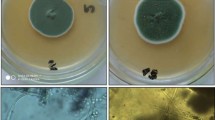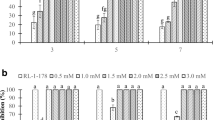Abstract
Panomycocin, a novel exo-beta 1,3 glucanase, was tested as an antifungal agent against green and blue mold diseases, the most important causes of post harvest decay in citrus fruits. All tested isolates of Penicillium digitatum and Penicillium italicum were susceptible to panomycocin in vitro. Effective panomycocin concentrations for 50% growth inhibition (MIC-2) for P. digitatum and P. italicum were 2 and 1 μg ml−1, respectively. Complete (MIC-0) growth inhibition of all isolates observed at a panomycocin concentration of 16 μg ml−1. Treatment of spores with panomycocin at values lower than the MIC-0 led to slower germ tube elongation and mycelium growth. In tests on fruit, panomycocin at concentrations equal to in vitro MIC-0 value protected lemon fruit from decay.




Similar content being viewed by others
References
Bar-Shimon M, Yehuda H, Cohen L, Weiss B, Kobeshnikov A, Daus A, Goldway M, Wisniewski M, Droby S (2004) Characterization of extracellular lytic enzymes produced by the yeast biocontrol agent Candida oleophila. Curr Genet 45:140–148
Bobek LA, Situ H (2003) MUC 20-Mer: investigation of antimicrobial activity, secondary structure, and possible mechanism of antifungal action. Antimicrob Agents Chemother 47:643–652
Bocco A, Cuvelier MA, Richard H, Berset C (1998) Antioxidant activity and phenolic composition of citrus peel and seed extracts. J Agric Food Chem 46:2123–2129
Bradford MA (1976) Rapid and sensitive method for the quantitation of microgram quantities of protein utilizing the principle of protein-dye binding. Anal Biochem 72:248–254
Chen H, Xiao X, Wang J, Wu L, Zheng Z, Yu Z (2008) Antogonisitc effects of volatiles generated by Bacillus subtilis on spore germination and hyphal growth of the plant pathogen, Botrytis cinera. Biotechnol Lett 30:919–923
Clinical and Laboratory Standards Institute. Reference Methods for Broth Dilution Antifungal Susceptibility Testing of Filamentous Fungi (2002) Approved Standards. CLSI Document M38-A. Wayne, PA: Clinical and Laboratory Standards Institute
Comitini F, Mannazzu I, Ciani M (2009) Tetrapisispora phaffii killer toxin is a highly specific β-glucanase that disrupts the integrity of the yeast cell wall. Microb Cell Fact 8:55–66
Dillard CJ, German JB (2000) Phytochemicals: nutraceuticals and human health. J Sci Food Agr 80:1744–1756
Droby S, Chalutz E, Wilson CL, Wisniewski ME (1992) Biological control of postharvest diseases: a promising alternative to the use of synthetic fungicides. Phytoparasitica 20:149–153
Ferrer P (2006) Revisiting the cellulosimicrobium cellulans yeast-lytic β-1,3-glucanases toolbox: a review. Microbial Cell Fact 5:10–16
Hemandez A, Martin A, Cordoba MG, Benito JM, Aranda E, Perez-Nevado F (2008) Determination of killer activity in yeasts isolated from the elaboration of seasoned green table olives. Int J Food Microbiol 121:178–188
Izgu F, Altınbay D (2004) Isolation and characterization of the K5-type yeast killer protein and its homology with an exo-β-1,3-glucanase. Biosci Biotechnol Biochem 68:685–693
Izgu F, Altınbay D, Sertkaya A (2005) Enzymic activity of the K5-type yeast killer toxin and its characterization. Biosci Biotechnol Biochem 69:2200–2206
Izgu F, Altınbay D, Türeli EA (2007a) In vitro activity of panomycocin, a novel exo-β-1,3 glucanase isolated from Pichia anomala NCYC 434, against dermatophytes. Mycoses 50:31–34
Izgu F, Altinbay D, Türeli AE (2007b) In vitro susceptibilities of Candida spp. to panomycocin, A novel exo-β-1,3-glucanase isolated from Pichia anomala NCYC 434. Microbiol Immunol 51:797–803
Li BB, Smith B, Hossain M (2005) Extraction of phenolics from citrus peels: I Solvent extraction method. Separ Purif Method 48:182–188
Liu X, Wang J, Gou P, Mao C, Zhu ZR, Li H (2007) In vitro inhibition of postharvest pathogens of fruit and control of gray mold of strawberry and green mold of citrus by aureobasidin A. Int J Food Microbiol 119:223–229
López-Garcia B, Gonzales-Candelas L, Perez-Paya E, Marcos JF (2000) Identification and characterization of a hexapeptide with activity against phytopathogenic fungi that cause postharvest decay in fruits. Mol Plant-Microbe Interact 13:837–846
López-García B, Veyrat A, Pérez-Payá E (2003) Comparison of the activity of antifungal hexapeptides and the fungicides thiabendazole and imazalil against postharvest fungal pathogens. Int J Food Microbiol 89:163–170
Magliani W, Conti S, Travassos LR, Polonelli L (2008) From yeast killer toxins to antibodies and beyond. Fems Microbiol 288:1–8
Makovitzki A, Viterbo A, Brotman Y, Chet I, Shai Y (2007) Inhibition of fungal and bacterial plant pathogens in vitro and in planta with ultrashort cationic lipopeptides. Appl Environ Microbiol 73:6629–6636
Moss MO (2008) Fungi quality and safety issues in fresh fruits and vegetables. J Appl Microbiol 104:1239–1243
Peng Y, Chi ZM, Wang XH, Li J (2009) Purification and molecular characterization of exo-beta-1,3-glucanases from the marine yeast Williopsis saturnus WC91–2. Appl Microbiol Biotechnol 85:85–94
Pitt JI (2000) A laboratory guide to common Penicillium species, 3rd eds. Food Science Australia, North Ryde, NSW
Sangorrin MP, Zajonskovsky IE, Lopez CA (2001) Killer behaviour in wild wine yeasts associated with Merlot and Malbec type musts spontaneously fermented from north western Patagonia (Argentina). J Basic Microbiol 41:105–113
Schmitt MJ, Breinig F (2002) The viral killer system in yeast: from molecular biology to application. FEMS Microbiol Rev 26:257–276
Selitrennikoff CP (2001) Antifungal proteins. Appl Environ Microbiol 67:2883–2894
Siegel MR, Kerkenaar A, Sijpesteijn AK (1977) Antifungal activity of the systemic fungicide imazalil. Neth J PI Path 83:121–133
Smilanick JL, Mansour MF, Margosan DA (2005) Influence of pH and NaHCO3 on effectiveness of imazalil to inhibit germination of Penicillium digitatum and to control postharvest green mold on citrus fruit. Plant Dis 6:640–649
Terol J, Conesa A, Colmenero JM, Cercos M, Tadeo F, Agustí J, Alós E, Andres F, Soler G, Brumos J, Iglesias DJ, Götz S, Legaz F, Argout X, Courtois B, Ollitrault P, Dossat C, Wincker P, Morillon R, Talon M (2007) Analysis of 13000 unique citrus clusters associated with fruit quality, production and salinity tolerance. BMC Genomics 8:31. doi:10.1186/1471-2164-8-31
Wuryatmo E, Klieber A, Scott E (2003) Inhibition of citrus postharvest pathogens by vapor of citral and related compounds in culture. J Agric Food Chem 51:2637–2640
Acknowledgments
This work was supported by a grant from the Scientific and Technological Research Council of Turkey (TUBITAK) (Project no: 104T495).
Author information
Authors and Affiliations
Corresponding author
Rights and permissions
About this article
Cite this article
Izgu, D.A., Kepekci, R.A. & Izgu, F. Inhibition of Penicillium digitatum and Penicillium italicum in vitro and in planta with Panomycocin, a novel exo-β-1,3-glucanase isolated from Pichia anomala NCYC 434. Antonie van Leeuwenhoek 99, 85–91 (2011). https://doi.org/10.1007/s10482-010-9527-0
Received:
Accepted:
Published:
Issue Date:
DOI: https://doi.org/10.1007/s10482-010-9527-0




